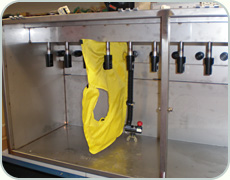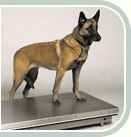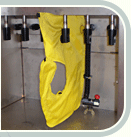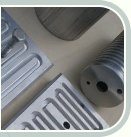
This equipment has been developed and manufactured by J-Tools in combination with the a maritime training centre. The equipment is intended for use for the cleaning, drying and testing of life jackets. A variety of other maritime training centres within Europe and further a field now use this piece of equipment.
The problem
Maritime training centres carry out safety training which is aimed at the specific dangers involved in the maritime sector. Most of the training takes place in the water. During these training sessions the participants use the life jackets from the training centre. These life jackets don�t only work as a rescue jacket, but also work as an oxygen supply during underwater escape training allowing people to breath for a short time underwater.
To prevent the spreading of contagious diseases it is important that after every underwater escape training the mouth piece and the air piece are thoroughly cleaned. It is also crucial for the training centre that the cleaning process takes as little time as possible. A life jacket that is used by a student one day, is used by a different student the next day.
The solution
When J-Tools received the request to develop equipment to streamline the cleaning process of the life jackets, they began by researching into which specific functions the equipment needed to fulfil. As a result of this it became apparent that there were three issues in the cleaning and ready for re-use process.
The first concerned the actual cleaning of the components. Manual cleaning was not only labour intensive but it also lacked a guarantee that the components had been thoroughly cleaned. The second issue was the drying process of the cleaned components. It was apparent from the research that a quicker drying process reduced the risk of bacteria growth. The third issue was that after every cleaning process the life jackets had to be reassembled, which meant that the air pressure had to be tested before the following student could safely use it.
In consultation with our client it was eventually decided that we should build a system which comprised of three components: a rinsing mechanism to clean the components, a drying compartment for the cleaned components, and a vacuum testing apparatus to test the reassembled life jackets. The equipment needed to be made out of stainless steel to enable it to function in wet surroundings and to withstand the use of aggressive cleaning agents.
Rinsing mechanism for cleaning the mouth piece and lung
The rinsing mechanism is made up of a few lockable stainless steel rinsing tubs which in a few easy steps and with the benefit of special cleaners � the different components in the life jacket can be first washed and then rinsed.
Drying compartment for drying of washed components
After the washing process the components need to be dried as quickly as possible to prevent bacteria growth. J-Tools have specially developed a compartment for this. The drying compartment is fully adjustable as far as drying time and air temperature.
Vacuum testing apparatus for the air pressure of the life jackets
When the jackets are dry they are then reassembled and the air pressure tested. This is carried out by vacuum testing apparatus developed by J-Tools.






